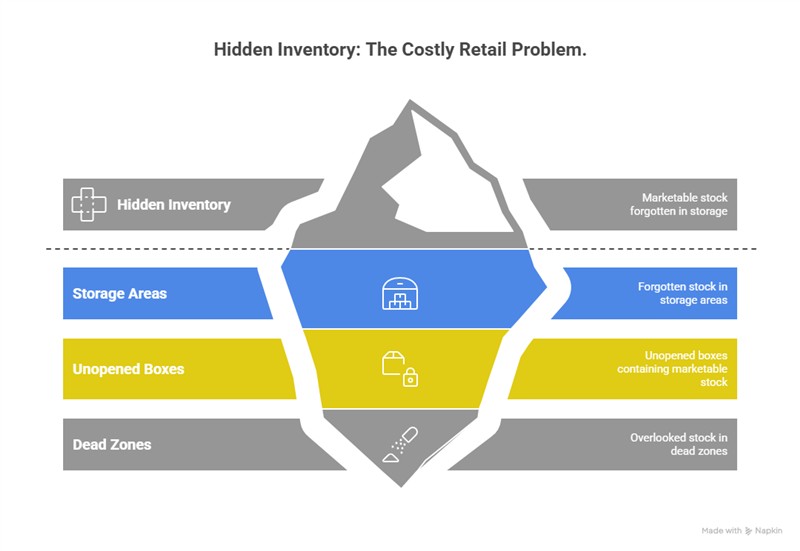Hidden Inventory in Retail: The Overlooked Cost
Hidden inventory often represents 15–25% of retail stock value

Hidden inventory, which includes marketable stock forgotten in storage areas, unopened boxes, and dead zones, can represent one of retail's most costly yet overlooked problems in inventory management and retail stock control.
Understanding Forgotten Stock vs Slow Stock vs Dead Stock
Let us first discuss what we are talking about.
Forgotten stock
It is marketable inventory that remains forgotten and hidden from customers. Often found in back rooms, under counters, and in unopened shipping containers. It is unsold or excessive inventory silently draining a business's profits through storage costs, potential obsolescence, and tied-up capital.
Slow stock
It is stock that moves only very slowly in your shop.
Dead stock
It is merchandise that has become unsellable, such as expired, damaged, or out-of-season items.
Point-of-sale reporting systems will often categorise these forgotten items as either slow or dead stock because their sales are so low. It misrepresents your inventory, as these items may be marketable but invisible to customers. This stock can be turned into working capital now.
Our recent installation of a POS system in a shop perfectly illustrates the scope of this problem. We found substantial quantities of saleable inventory stored in unopened boxes throughout the shop — some never accounted for in their stocktake. These were marketable products removed from sales simply because they were forgotten.
In my experience, a major cause of this problem is that suppliers often encourage you to purchase excess stock to maximise their own revenue objectives.
Why Suppliers Create Hidden Inventory Problems
Suppliers often push stock to achieve revenue goals and secure loyalty. If your stockroom is full of Supplier A’s products, you are less likely to purchase from Supplier B. Understanding these motivations is key to preventing future accumulation, but first you need to identify your existing hidden inventory.
How to Find Hidden Inventory in Your Shop
Computer audit
Run a slow and/or dead stock report in your POS software. In less than a minute, you’ll have a clear list of items not selling. Many retailers are surprised at the forgotten value uncovered this way.
Physical search
Look for unopened boxes in your storerooms, under counters, and even at home if you keep stock in a garage. These often hold saleable goods overlooked in daily operations.
Dead areas
Check shelf areas where items rarely sell. Products in these dead zones may be perfectly marketable, just poorly placed.
Inventory Management System
If hidden stock is a recurring issue, the root cause usually lies in purchasing decisions. Review controls in place before ordering to avoid repeating the cycle.
Make a realistic sales projection
Use AI-driven sales projections if available in your POS system. Otherwise, analyse seasonal trends, current performance, and historical sales before ordering. Base purchases on what you realistically need now.
Technology solutions
Leverage ordering reports and review them regularly. Even basic POS systems can automate recommendations. While not perfect, they save time and reduce the risk of overbuying.
Timing
Only order what you need now, especially if your supplier can deliver in a week. Adopt a “small and often” approach where possible.
What do you have
Check existing stock before placing new orders. Selling through older inventory prevents waste and frees up cash flow.
Space
Ensure you have space to display new products. Forgotten stock often sits in storage simply because there was never room to display it in the first place.
Retail Stock Control Strategy
Successful stock management requires ongoing, systematic effort. Today’s retail success depends on efficient capital deployment and operational discipline. Forgotten stock is inexcusable — begin with a complete stock audit now.
Written by:

Bernard Zimmermann is the founding director of POS Solutions, with 45 years of experience, now retired and consulting businesses to optimise operations and enhance customer experiences through POS technology.


